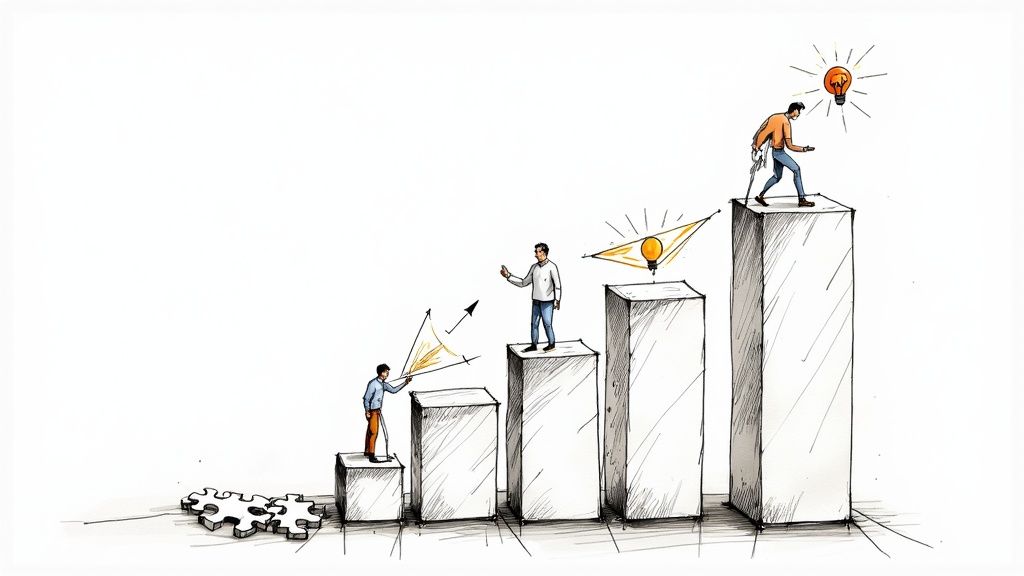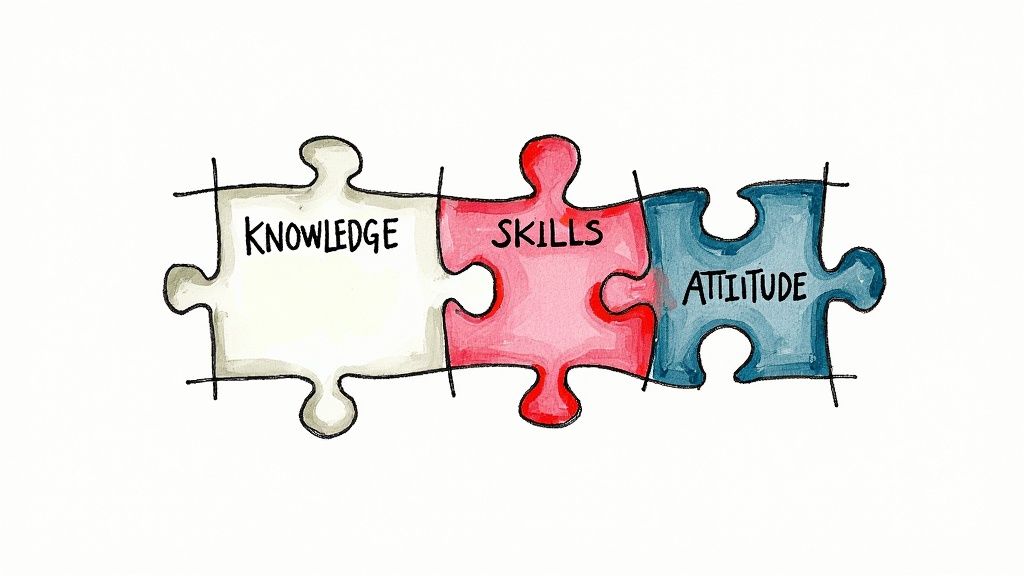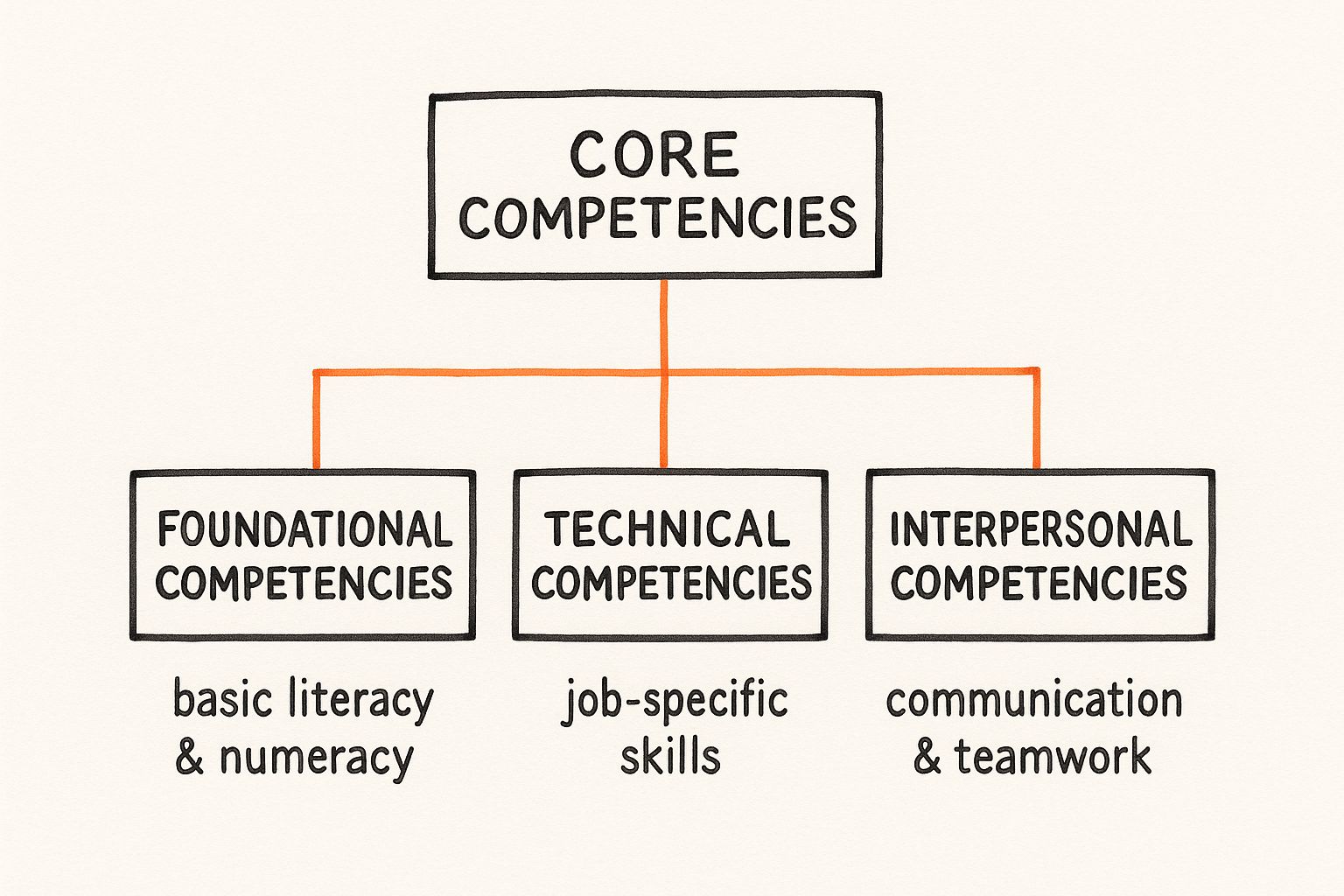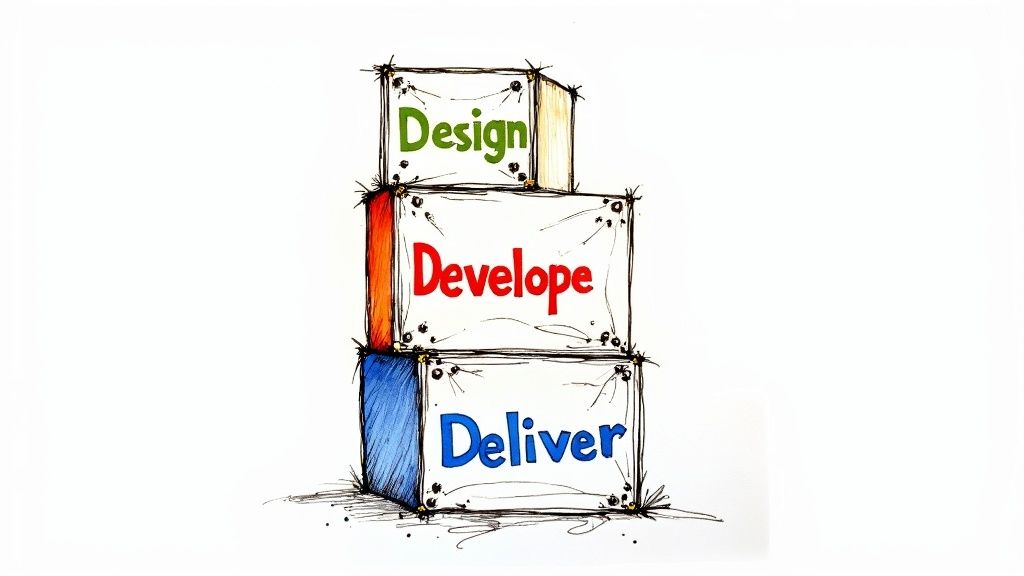
A competency-based training approach is all about one thing: mastering real-world skills. Forget about clocking in a certain number of hours in a training room. This model cares about what an employee can actually do once they're back at their desk, making sure they’re genuinely ready for the job.

Let's be real for a second. We've all been there—stuck in a mandatory, all-day training session, eyes glazing over, only to forget almost everything a week later. The old one-size-fits-all model is built on a flimsy premise: that just showing up and spending time in a seat automatically equals learning.
The problem is, this approach treats everyone like a carbon copy. It ignores their existing knowledge and personal learning speed, forcing the entire group through the same material at the same pace. Fast learners get bored, and those who need a bit more time get left in the dust. You end up with a team that has a "training complete" certificate but lacks the practical skills needed to tackle today's challenges.
The fundamental flaw in time-based training is its focus on input (hours) over output (proven ability). Sticking to that outdated method is a recipe for disaster if you're trying to build a quick-thinking, skilled team.
Think about the downsides of the traditional model:
This is exactly where the competency-based training approach flips the script. It’s a complete game-changer.
Instead of asking, "Did you complete the training?" it asks, "Can you demonstrate the skill?" That simple change in perspective is everything when it comes to building a truly capable team.
Moving toward skill mastery isn't just a feel-good idea; it delivers real results. The data shows that Competency-Based Training (CBT) has a direct and positive effect on performance. Because CBT is all about mastering specific, targeted skills, it’s been shown to boost learning effectiveness by around 20%.
Even better, companies that switch to this model often see a 30% reduction in employee turnover, mainly because their people feel genuinely supported and invested in. You can dig deeper into how competency models drive business results on verifyed.io.
When you start focusing on what your team can do, not just what courses they've attended, you build a workforce that's more motivated, adaptable, and ready for whatever comes next. Training stops being a passive, check-the-box event and becomes an active, ongoing part of building a team that achieves its goals.

Let's cut through the jargon. Think about getting a driver's license. You don't get handed one just for logging 40 hours behind the wheel. You have to prove you can actually parallel park, merge onto the highway, and handle the car safely.
That’s the essence of the competency-based training approach. It's not about how much time someone spends in a training session; it's about whether they can actually do the thing you need them to do. It shifts the focus from "time served" to "skills mastered."
At its core, this whole approach is built on a simple but powerful idea: learning should be measured by what people can demonstrate, not just by what they've been taught. It starts by defining specific, observable skills—the competencies—and then lets people learn at their own pace until they can prove they’ve got it down.
To really get it, picture a three-legged stool. If one leg is wobbly or missing, the whole thing falls apart. The same goes for competency-based training.
The whole point of competency-based training is to ensure skills are truly mastered, not just taught. This philosophy makes sure what happens in training actually translates to better performance on the job.
The difference really comes to life when you see it side-by-side with a more traditional approach.
Imagine a group of new managers in a mandatory eight-hour workshop on "Effective Feedback." In the old-school model, everyone sits through the same PowerPoint presentation. At 5 p.m., they all get a certificate. But can they all give great feedback now? Probably not. One manager might have been a natural from the start, while another is still sweating at the thought of a tough conversation.
Now, let's run that same training using a competency-based training approach. The specific competency we're aiming for is: "Deliver constructive feedback using the STAR method."
They keep practicing until they can confidently demonstrate the skill to a coach or mentor. They only move forward when they’ve proven they can nail it. The result is a team of managers who can actually do the very thing they were trained for, which builds a much stronger organization.
You can't just wing it when it comes to competency-based training. You need a solid blueprint. Think about it like building a house—you wouldn't start picking out throw pillows before the architect has even drawn up the plans. This framework is your plan, detailing every single skill your teams need to knock it out of the park.
It’s all about getting specific. We’re moving beyond vague job descriptions to pinpoint the exact skills that matter. That means everything from technical know-how, like mastering a new piece of software, to the soft skills that make or break a team, like communication and leadership. The goal is to draw a clear map connecting what people can do with how the business performs.
First things first: you need to figure out what "good" actually looks like for every role. This isn't about job titles; it's about breaking down jobs into their core skills. What makes a top-performing project manager different from an average one? The secret is in their specific competencies.
This is where you want to get everyone involved. Chat with your star players, team leads, and even your customers to get the real scoop on what skills truly move the needle. These conversations give you the raw material to build a list of competencies that are directly tied to real-world success.
To keep things organized, it's helpful to group these skills into categories. The image below shows a pretty standard way to structure them.

This kind of structure ensures you’re not missing anything important. You cover the basics everyone needs, the technical skills for specific jobs, and the people skills that hold everything together.
This whole idea of focusing on real-world skills isn't exactly new. Historically, Competency-Based Learning (CBL) grew out of the need to close the gap between what schools were teaching and what employers actually needed. This shift was all about proving you could do the job, not just that you passed the final exam.
Okay, so you've listed out your key competencies. Now what? Just saying someone has "communication skills" is way too vague. You need to know how well they communicate. This is where proficiency levels are a game-changer.
A typical scale might break down like this:
These levels give everyone a shared language to talk about performance and growth. Employees see a clear ladder to climb, and managers can give feedback that's actually useful. This whole approach fits hand-in-glove with the core ideas of great training design, which always focus on measurable progress. This lines up perfectly with many of the essential instructional design principles we live by.
By mapping skills to clear proficiency levels, you turn an abstract concept like "leadership" into a tangible, measurable, and developable trait. This clarity is the engine of a successful competency-based training approach.
Ultimately, building this framework is what turns your training from a bunch of random workshops into a smart, connected system. It's the foundation for everything that follows: personalized learning, fair assessments, and real career paths that empower your people and drive your business forward.
A modern competency-based training program is more than just a philosophy; it’s a living, breathing ecosystem powered by technology. The right tech stack is what turns the theory of skill mastery into a reality you can actually scale, track, and make engaging for your teams. Without these tools, you're just left with great ideas and no practical way to bring them to life across the entire organization.
This isn’t just about delivering content. It’s about building a connected system where skills are clearly defined, learning is personalized, and mastery is measured in a meaningful way. From the central hub of your learning platform to the specific tools you use to create content, every single piece plays a crucial role.
At the heart of any modern learning strategy, you’ll find two key players: the Learning Management System (LMS) and the Learning Experience Platform (LXP). They serve different purposes, but both are essential for a solid competency-based approach. Think of the LMS as the foundational operating system and the LXP as the user-friendly interface that makes learning feel natural and intuitive.
Your LMS is the administrative backbone. It's the command center where you can:
The LXP, on the other hand, is all about the learner's journey. It pulls content from all over the place—your LMS, external libraries, internal wikis—and serves it up in a personalized, Netflix-style feed. An LXP is perfect for encouraging self-directed learning, letting employees explore topics that align with their own career goals. To get a better handle on the differences and how they work together, you can dig into the various types of learning management systems out there.
Once you have your platform sorted, you need great content—content that’s actually built for skill acquisition. This is where authoring tools like the Articulate Suite (including Storyline and Rise) or Adobe Captivate come in. These aren't for making static PowerPoints; they're designed for creating interactive, skill-focused learning experiences.
They’re especially good for building microlearning modules. These are short, bite-sized lessons that focus on a single competency. So instead of a two-hour slog on "customer service," you might create a five-minute module on "how to de-escalate an angry customer call." This super-focused approach lets people practice and master one skill at a time.
With these tools, your instructional designers can create things like:
This modular content can then be tagged with specific competencies and uploaded into your LMS or LXP, creating a rich, searchable library of skill-building resources.
Artificial Intelligence (AI) is the secret sauce that makes a competency-based training program truly dynamic and data-driven. AI integrates with your learning platforms to add a layer of intelligence that just wasn't possible before. It’s the "smart" in your smart learning ecosystem.
AI is becoming a game-changer in a few key areas:
The global investment in this space really tells the story. The market for competency-based education spending is projected to hit USD 1.805 billion by 2025. This growth is being driven by systems that use competency mapping and proficiency tracking to directly tie skill development to real business outcomes.
Technology doesn't replace the need for a solid instructional design strategy, but it amplifies its impact. By weaving together an LMS, LXP, authoring tools, and AI, you can create a learning environment that is efficient, personal, and directly tied to measurable skill improvement.

Alright, so you're sold on the theory. But how do you actually get a competency-based training approach off the ground? It can feel like a massive undertaking, but the secret is to start small. Think of it less like a company-wide revolution and more like a focused, manageable pilot project.
The best way to begin is by acting like a scientist. You'll form a hypothesis, run a small-scale experiment with a single team, and then use the data you collect to guide your next steps. This approach lets you iron out the wrinkles and build some early momentum without having to tear down your entire L&D structure overnight.
First things first: you need to decide who you're building this for and what, exactly, they need to be able to do. Your initial step is to pick a small, well-defined pilot group. This could be a team of new sales hires, a handful of first-time managers, or maybe the customer service crew handling a brand-new product.
Once you’ve got your group, sit down with their managers and some of the team's top performers. Your goal is to identify the 2-3 critical competencies that will give them the biggest, most immediate performance boost. Don't try to boil the ocean here. Keep it simple.
For instance, with those new managers, you might land on:
This laser focus makes sure your pilot is built around real-world, high-impact skills. That makes it way easier to measure success and chalk up some early wins. Getting this planning stage right is a hallmark of people who have built successful careers in learning and development.
You've defined the skills. Now, how will you know when someone has actually mastered them? This is where your assessment design comes into play. Forget the standard multiple-choice quiz; a true competency-based training approach demands that people demonstrate their skills.
A great assessment isn't about what a learner knows; it's about what they can do. It should feel just like the real-world challenges they face every day.
For that manager-feedback skill, a solid assessment might be a role-playing scenario where they have to give tough feedback to a simulated employee. Tools like the Articulate Suite or Adobe Captivate are fantastic for building these kinds of interactive challenges. For the delegation skill, maybe they have to submit a real project plan showing how they’d assign tasks.
Next up is the learning content itself. Good news: you probably don't need to create everything from scratch. Start by curating what you already have into bite-sized microlearning modules. Pull together short videos, helpful articles, and quick-reference guides that directly map to your chosen competencies. You can organize all this in your LMS or LXP, tagging each piece of content to the specific skill it builds.
Time to go live with your pilot! Set clear expectations with both the learners and their managers. Make sure everyone understands that this is a different way of learning—the goal is skill mastery, not just ticking a box for course completion. As your team works through the program, your role naturally shifts from being an instructor to more of a coach.
Now for the most important part: gathering feedback. You need to know what's hitting the mark and what's falling flat. Use a mix of methods to get the full picture:
This feedback loop is what will make your program truly great. Maybe a video was confusing, or an assessment felt a bit too staged. Use these insights to tweak and refine everything. Your pilot is just version 1.0. The real magic happens as you use data and honest feedback to make each new version better than the last, creating a proven model you can confidently roll out to the rest of the company.
So, how do you prove that your shiny new competency based training approach is actually paying off? The old way of doing things—tracking course completion rates—just doesn't cut it anymore. That tells you who showed up to class, not who got better at their job.
To show you're making a real difference, you have to stop focusing on training activity and start looking at tangible business outcomes. It’s all about connecting the dots between the skills your team is building and the key performance indicators (KPIs) your leadership team actually cares about. This is how you shift Learning & Development from being seen as a cost center to a vital, strategic partner in the business.
First things first: ditch the vanity metrics. Tracking how many people clicked "complete" on a module is easy, but it's not meaningful. What you really need to measure is whether people are actually learning new skills and, more importantly, using them on the job.
Your modern metrics dashboard should look a little different. Think about tracking things like:
This kind of data-driven approach gives everyone a much clearer picture of whether your training is truly working.
To really nail down your ROI, you need to draw a straight line from competency development to the company's bottom line. It's not just about making employees "better" in a vague sense; it's about making the business perform better in a measurable way.
The most powerful way to prove your program's worth is by showing a direct link from a newly acquired skill to a measurable business improvement. When you can say, "We improved competency X, which led to a 15% reduction in Y," you've won.
Let’s take an example. Say you roll out training on "Effective Project Scoping" for your project managers.
That difference has a clear dollar value you can take straight to your leadership team. It's undeniable. You could do the same for communication skills, maybe measuring them with assessments in a tool like Articulate, and then see if customer satisfaction scores go up. This is how you prove that investing in your people is one of the smartest business decisions you can make.
Making the leap to a competency-based training approach is a big move, and it’s bound to stir up some questions. It’s a totally different way to look at employee development, so it's only natural to wonder how it plays out in the real world. Let's dig into some of the most common things that pop up for L&D pros and instructional designers.
Getting clear on these points from the start helps build confidence and paves the way for a smoother rollout for your whole team. The idea is to move forward knowing exactly what to expect.
This is one of the biggest perks of competency-based training, but it can feel like a logistical headache at first. What happens when one person breezes through a module in a day, but their teammate takes two weeks?
The secret is to create a learning environment that’s both flexible and supportive. Instead of seeing varied pacing as a bug, treat it as a feature.
The sheer number of L&D tools available can be dizzying. The good news? You don't need every new gadget on the market. You just need a solid foundation of a few core tools that play nicely together.
Start by looking for platforms built with a skills-first mindset. You'll want a Learning Management System (LMS) that lets you define competency frameworks and actually track how people are progressing against them. Layering on a Learning Experience Platform (LXP) can then create a more personalized feel, using AI to suggest bite-sized microlearning content based on someone's specific role and skill gaps.
Your tech stack should follow your strategy, not define it. Find tools that make it simple to map skills, deliver the right content at the right time, and measure what people can actually do.
Let's be blunt: manager buy-in is a deal-breaker. If your managers don’t get it or, worse, don't support the competency-based training approach, it’s doomed to fail. They're on the front lines, reinforcing what's learned and seeing it applied (or not) on the job.
The key to winning them over is to focus on WIIFM—What's In It For Me? Frame the conversation around the benefits that will make their jobs easier and their teams stronger.
Tackling these common questions with a solid plan can transform doubt into real enthusiasm, setting your competency-based program up for success from day one.
At Relevant Training, we specialize in developing engaging eLearning content that helps businesses like yours build a truly skilled workforce. We also host a niche job board for the learning industry. Check out how we can help you at https://relevant.training.